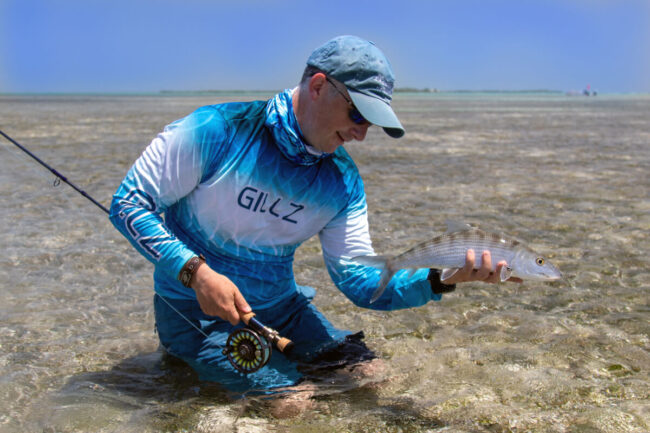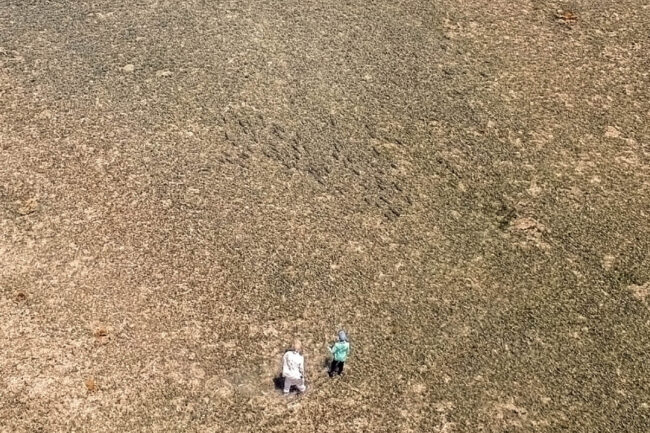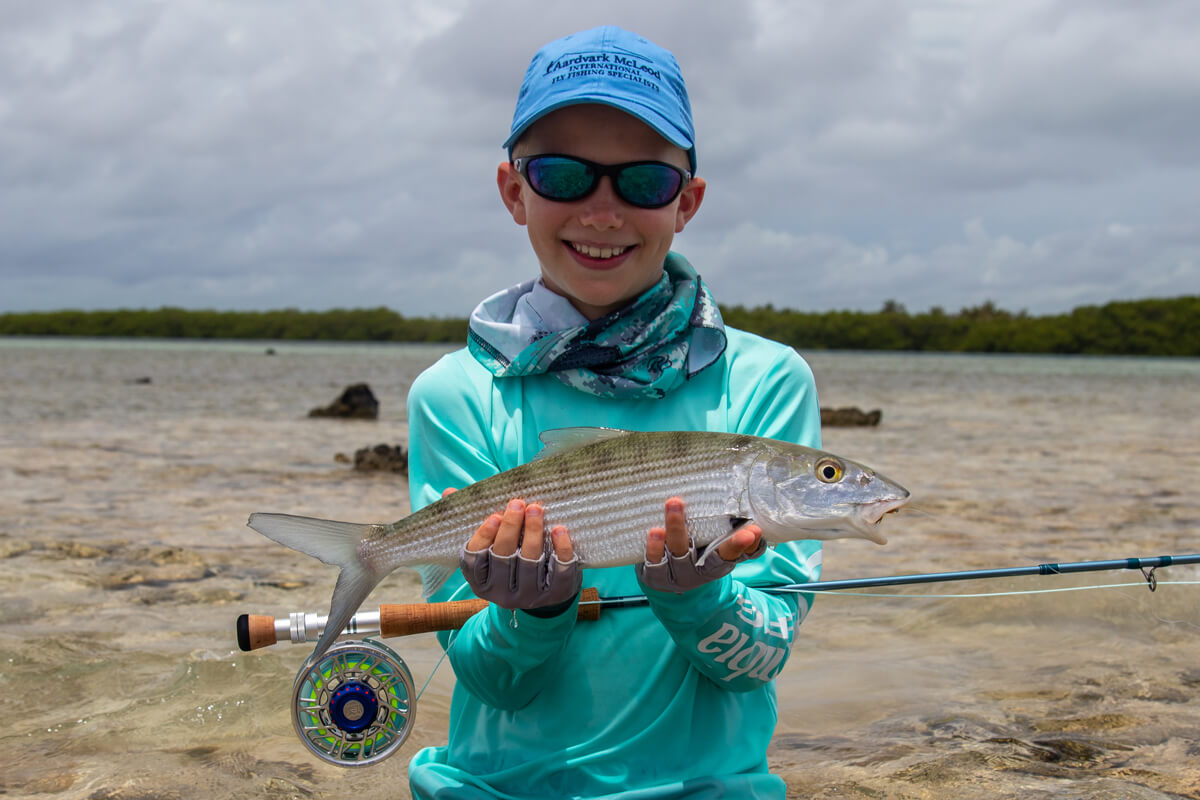I recently embarked on a fly fishing adventure—and not quite the usual adventure I have on fly fishing trips. This adventure posed a whole new set of challenges, many of which I had never before encountered. No, it wasn’t getting to some far-flung area of the globe, or having to perform some technique I was unfamiliar with. I’ve been trying to ascertain what it is I really love about our sport of fly fishing, and I think I have it: It’s sharing knowledge with others that I get such a big kick out of. Last year it dawned on me that the ones I needed to share that knowledge with most are the next generation of fly anglers and those closest to me: my own children. The number of times they’ve watched me pack my gear as I set off on another fishing expedition is countless, and it’s always accompanied by, “No, I am sorry, you can’t come yet as you are too young.”
Well, as they’re seven and ten years old, I realized the answer now should be yes. I’ve taken them fishing many times on rivers and lakes here in the United Kingdom, and both of them have always been keen. I’ve always been very careful not to push fishing on them, or make them stay longer than they wanted to, in case it had a negative effect rather than a positive one. However, I had never taken them on a full-fledged international fishing trip, and I figured the time was nigh. Thomas, my oldest, has always been fascinated with tales of bonefish and saltwater species, and they both thrive in that tropical environment. As my wife, Elisabeth, has always loved bonefishing, this seemed the perfect opportunity for a family fishing adventure.
The next question was, Where? As this is what I do for a living, you would think that would have been easy, but it did take some thought. Then It hit me that the obvious choice was Turneffe Atoll in Belize. Why? That’s where I caught my first bonefish with my family—a trip that I have never forgotten. Taking Elisabeth and our children there would complete the circle. I began making arrangements.
One evening last autumn, I switched off my children’s usual YouTube viewing, flipped it over to the Aardvark McLeod YouTube channel, and put on a video of Turneffe Flats Lodge in Belize. The two of them watched the whole thing through, captivated by the location, the beaches, the bonefishing, and running around in flats skiffs. When their questions subsided, I hit them with the news: We were going there in August of the following year. A small riot of excitement ensued. This was exactly the reaction I was hoping for.
Over the next six months, a continuous stream of fishing kit began to stack up in the sitting room. I acquired each of them a Hardy Demon Saltwater 7-weight rod matched with a Hardy SDSL 8000 reel. We would spend some time each Sunday practicing casting in the park. Slowly but surely, they developed reasonable casting skill, with Thomas beginning to double haul after studying a Lefty Kreh DVD. I supplemented their casting practice by grabbing the end of the line and mimicking bonefish runs so they would feel comfortable with pressure and retrieve. I also offered them some tips on avoiding obstacles.
Finally, August was upon us. Our bags were packed, and the ten-month preparation period was over. I was excited.

Our journey began with a flight to Miami, the discovery of pancakes and bacon, the Miami Seaquarium, South Beach, and the sun setting over Biscayne Bay. We then flew down to Belize City, where I had a small surprise waiting for them. Rather than our taking the 90-minute boat journey out to the atoll, I had arranged a helicopter transfer. As none of them had ever travelled by helicopter, this was a whole new level of excitement. As we flew over Belize City and over the outer cays, Turneffe Atoll came into view, giving them an incredible perspective of where we were going and the remoteness of our location.
Having settled into one of the family apartments of the new Pelican Villa, we looked out across Home Flat in front of us, and I immediately began looking for fish. (What can I say? I just can’t help it!)
Elisabeth and I had agreed we would take the children out fishing each morning until they had had enough, and then we’d return to snorkel, swim, relax, and enjoy the island. We would alternate between them and fish close together so we could share the experience as a family.
The first morning we ran north in the flats boats to one of the last cays on the atoll, Mauger Cay, where our guides, Dubs and Alton, knew a large school of bonefish lurked in what is known as a mud. This is deeper water where a huge number of bones congregate and feed. It was the perfect spot for both children to get off the mark and hook some fish, figure out what it was all about, and practice some of the skills they had learned. It didn’t take long, and after some huge excitement, both of them were cradling their very first bonefish. For me this was quite special, as it took me back to my first bonefish here 20 years earlier. Thomas and Grace proceeded to land over 20 fish in a couple of hours. I wasn’t sure which they enjoyed more—the fishing or the speed of the flats skiffs!

The following day I graduated them from the muds onto the actual flats around the coral reef. The big, open flats areas stemmed from channels near the mangroves, up over the turtle grass to the rough, broken-coral areas of the reef itself. We could see barracuda patrolling the deeper edges and hanging in white holes, looking for an easy meal. Way up in the skinniest water, often amongst the broken coral, were large schools of bonefish, often tailing or showing their backs. This is not the easiest environment in which to hook and land bonefish, and it certainly presented a challenge—one that my son relished. Thomas had already flipped into predator mode, and with the help of his guide, Dubs, he was more than capable of sneaking up around the back of these fish and presenting a tiny Bonefish Bitters on a long leader.
I watched him stalk down to some tailing fish, and I was very proud to see him throw a lovely loop that stopped above the fish and then gently dropped to one side. The rod tip went down—twitch, twitch, and strip set! He was into a lovely 3-pound-plus fish that streaked off across the flat like a silver bullet as the rest of the school exploded in panic. Dubs was clapping his hands and clasping Thomas’ shoulder like a proud uncle. Thomas weaved the fish in and out of the sharp coral before he brought it safely to hand with a beaming grin. Seeing this vista unfold was not the highlight for me; rather, it was watching the expressions on Thomas’ face. I saw the mixed emotions of concentration, surprise, nervousness, and utter elation. I watched a passion ignite in him that might one day equal my own.
Grace, too, was enjoying the experience, though at only seven she was struggling with casting in the wind. She was more than content to stick close, participate in the stalk, and then take over once the fish was hooked. The first fish I hooked on the edge for her was not large, between 2 and 3 pounds. As I checked the drag and handed her the rod, the fish took off, and she watched the backing start heading very quicly across the flat. The vague look of terror was replaced with grim determination, and slowly but surely she started to gain ground. After what seemed like an age and a couple more blistering runs, the leader was in sight and I could see the fish. Sliding across the flat about 5 feet behind it was a massive barracuda, which obviously was reckoning on an easy meal. I charged it, flailing and splashing as I ran, and I sandwiched myself between it and the bonefish. I knew murder would ensue if Grace lost that fish after all the hard work she had put in. Luck was on our side: The barracuda backed away and soon we had the bonefish to hand.
The week progressed and both Thomas and Grace found their feet. Alton had been a marine researcher at one of the stations on Turneffe for 15 years, so as soon as Grace had had enough, he would take her by the hand across the coral and show her the flora and fauna inhabiting the flats and coral rock pools. Dragon snails, urchins, gobies, and crabs kept her captivated. The snorkeling and diving at Turneffe Atoll is phenomenal, so we kept snorkeling kit in the focsles of the skiffs. When the children had had their fill of wading the flats and chasing tails, the guides would take us to a suitable spot where we would snorkel together as a family under their watchful eye. Alton came into his own here as he could point out particular items of interest that the untrained eye would miss, such as a sleeping nurse shark tucked under an overhang (harmless!), lobster, grumpy octopus, or various species of crab. This allowed Thomas and Grace to experience a world they don’t normally see and to learn more about what lies beneath the water they had spent so much time gazing into. Afternoons were spent lazing by the pool, kayaking around Home Flat, husking coconuts, or just chilling under a palapa. Time slipped away into island life and the children slipped into early beds after tiring days.
On the last day the guides took us south to a stunning area called Calabash Cay, a huge shallow flat with mangrove islands and the ocean lapping over the edge of the reef. On arrival we could already see the glint of silvery tails in the waves and I felt my pulse quicken. After a short while the children announced they were tired—it had been a long week!—so we built them a den on one of the skiffs from the mooring rope and some towels and left them to it. They would be in sight wherever we were, so Elisabeth and I had the chance to spend some time fishing ourselves with the guides. I found some fish tailing against the pilings of a long-since-disappeared dock and managed to land one. Elisabeth hooked up but sadly was coral-cut. There’s something truly magical about hunting bonefish in really skinny water; the tails give away their position but also their mood. Stealth, long leaders, small flies and accurate casting are required, but the rewards are huge.
On the return ride to the lodge, the guides allowed the children to hold the tiller of the motor, which I suspect blew their minds.
Sadly, the journey had come to an end and it was time to leave this island paradise. For Thomas and Grace, this journey to the other side of the world gave them countless new experiences that will broaden their horizons as they grow. It has brought them closer together as siblings and us as a family through shared experience. I am sure, like myself and my wife, this trip will remain carved in their memory for the rest of their lives.
Fact Box – Family Fishing Trips
There are a few things I have learned about putting together trips for families over the years, especially those involving children. If you want children to engage with fishing, they must catch fish pretty quickly, especially the first time out, or they’ll lose interest fast. Bonefishing trips work well, as it’s visual and the beach environment is always a hit, even without fishing. With that in mind, destination such as Belize, Mexico, the Bahamas, or the Seychelles are excellent. Plenty of fish, experienced, patient guides, and comfortable, well-established accommodations remove all stress and ensure your children will get the most out of the trip. Turneffe Flats had the added benefit of phenomenal snorkeling in a safe environment.
Bio: Peter McLeod began guiding fly anglers for Atlantic salmon in Norway at the age of 16. He is the founder of Aardvark McLeod, international fly fishing specialists. Peter is the author of the acclaimed GT: A Fly-Fisher’s Guide to Giant Trevally (Merlin Unwin Books, 2016). For more information on putting together a family fly fishing trip, you can contact Peter through www.aardvarkmcleod.com.


